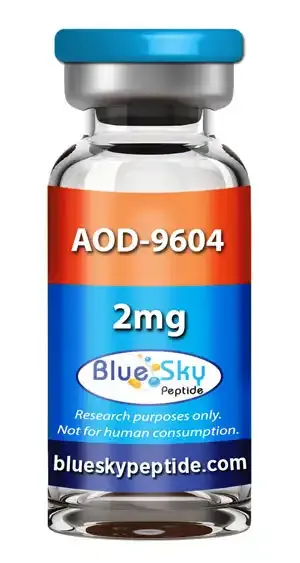45% Off Everything*
Save Now!!

Availability: In stock

| Unit Size | 2mg/vial |
| Unit Quantity | 1 vial |
| Purity (Mass Spectrometry and UV) | 99.82% |
| Sequence | H-Tyr-Leu-Arg-Ile-Val-Gln-Cys(1)-Arg-Ser-Val-Glu-Gly-Ser-Cys(1)-Gly-Phe-OH |
| Molecular Formula | C78H123N23O23S2 |
| Appearance | Lyophilized White Powder |
| Source | Chemical Synthesis |
| Storage | Lyophilized AOD-9604 is Stable at room Temperature for 90 days, however it is best to store in a freezer below - 8c for any extended period of time. |
| Terms | The products we offer are intended for laboratory research use only. Please familiarize yourself with our terms of service prior to ordering. |
AOD9604 2mg is a synthetic form of human growth hormone (HGH) designed to enhance fat breakdown and boost energy expenditure.(1) Note: All research referenced here is based exclusively on in vitro (laboratory-based) studies, which explore the potential effects of AOD9604 on fat cells, metabolic pathways, and cartilage health.
Potential Effects of AOD9604 on Fat Metabolism: In a key in vitro study, researchers found that AOD9604 promotes fat breakdown in adipocytes (fat cells) and enhances the expression of genes related to fat metabolism.(3) This suggests possible applications for obesity and metabolic health, although additional research is required to validate these findings.
Role of AOD9604 in Glucose Metabolism: Another in vitro study evaluated AOD9604's impact on glucose uptake and insulin sensitivity in muscle cells, showing results that may be relevant to type 2 diabetes.(1)
AOD9604 and Joint Health: Research also indicates that AOD9604 may support cartilage health by increasing collagen and proteoglycan production, which are key components of joint cartilage. Additionally, it may reduce inflammatory cytokines that contribute to joint tissue breakdown in osteoarthritis.(4,5) These findings highlight the peptide’s potential for joint health applications, though more studies are needed.
Safety of AOD9604: A study published in the Journal of Endocrinology and Metabolism assessed the safety of AOD9604 on various cell types, finding no toxic effects in the tested cells. This suggests a favorable safety profile for further study.(6)
Important Note: These findings are based exclusively on in vitro studies conducted in laboratory environments. This product is not intended for human use or consumption. Further research, including animal studies and clinical trials, is essential to determine the safety and efficacy of AOD9604 for therapeutic purposes.
Conclusion: AOD9604 shows promise in in vitro studies for its potential effects on fat metabolism, glucose uptake, and cartilage health. However, its application is currently limited to laboratory research, and more comprehensive studies are needed to explore its potential as a therapeutic agent.
References: